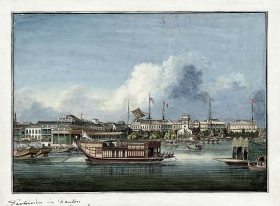Featuring the famous Chinese ingredient: ketchup.
|
Shrimp and yam in chili sauce by T-mizo, on Flickr |
Well, I’m not being funny, although the truth is a little more complicated than that. The most likely origin of the name ketchup is a Chinese fish sauce with a name that sounds a bit like kê-chiap in Mandarin. British sailors were likely exposed to it in Singapore, a major trading post for the East India Company, in the early 18th century.
Most Western ketchups in the 1700s were vinegar-based and included some amount of anchovy; the consistency of these sauces would’ve been more along the lines of a Worcestershire. American colonists brought along the concept, and while some early American ketchups used berries, mushrooms, and other additives to change the taste, the basic recipe relied on vinegar and anchovies.
Consider the following example from the 1830’s anonymously-authored The Cook Not Mad:
|
No. 274. An excellent Ketchup which will keep good more than twenty years.
Take two gallons of stale strong beer, or ale, the stronger and staler the better; one pound of anchovies, cleansed from the intestines and washed, half an ounce each of cloves and mace, one quarter ounce of pepper, six large roots of ginger, one pound of eschalots, and two quarts or more of flap mushrooms, well rubbed and picked. Boil these ingredients over a slow fire for one hour; then strain the liquor through a flannel bag, and let it stand till quite cold, when it must be bottled and stopped very close with cork and bladder, or leather. One spoonful of this ketchup to a pint of melted butter, gives an admirable taste and colour, as a fish sauce, and is by many preferred to the best Indian soy. |
At some point in the early 19th century, American cooks started making tomato-based ketchups that were thicker and less salty. (But I don’t think 1801 is the correct date; the cookbook most sources cite as the earliest tomato ketchup recipe contains recipes later than its supposed publication date.)
So what does this have to do with Szechuan shrimp? Let’s back up half a century-ish.
You might remember that many of the objections the Americans had to British rule around 1776-ish took the form of tea-related protest. While the Second Treaty of Paris in 1783 ended formal hostilities between British and American naval forces, most British colonies in the Atlantic were closed to trade with American ships. Nevertheless, the American public wanted tea. Just not British tea.
In 1784, the first American ship reached China; its owners made a substantial profit trading coins and ginseng for tea, then selling the tea when it returned to New York in 1785. This informal, non-governmental trade continued undisturbed until 1844, when it was modified with slightly more formal terms. And it was likely sometime before 1844 when tomato ketchup was carried by Americans back to the Chinese, where coastal Chinese chefs incorporated it into their dishes, as they did every food product that passed through the ports.
The next time you find yourself sitting across from a snob in a Chinese restaurant who wants to argue over the authenticity of ketchup, offer him or her this little reminder, in light of the fact that hamburgers (at least under that name) didn’t really exist until around 1900: the Chinese have been putting ketchup in their shrimp longer than Americans have been putting it on hamburgers.
From a box sold in Martinez, California.
Shrimp in Tomato Chili Sauce
1 lb. shrimp, shelled and black vein removed
1 t. wine
2 t. cornstarch
oil for deep frying
2 t. ginger, finely chopped
5 T. onion, finely chopped
1 t. red chili pepper
3 t. oil
Sauce
1 t. salt
2 t. sugar
4 T. tomato ketchup
1 T. cornstarch mixed with 1/2 c. water
- Mix shrimp with wine, chili pepper, ginger, onion, and 3 Tbsp. oil; toss to coat. Then sprinkle with cornstarch, coating each shrimp to the extent possible. Cover bowl with plastic wrap and refrigerate for 30 minutes.
- Saute shrimp in oil; when cooked through (about two minutes over high heat), set aside.
- Add cornstarch mixture, salt, and sugar to pan shrimp was cooked in; stir quickly to thicken and incorporate anything left from the shrimp.
- When sauce is thickened, add shrimp back to the pan and toss in sauce. Serve.




